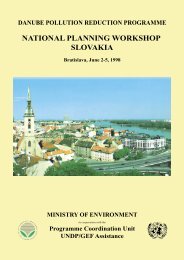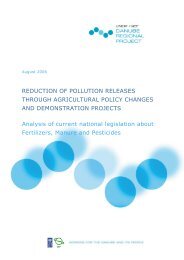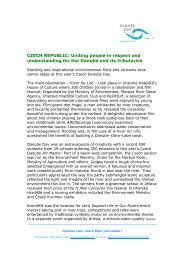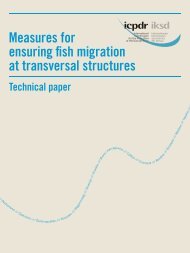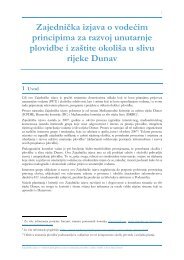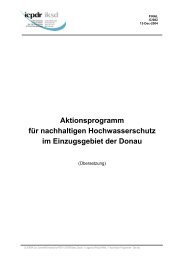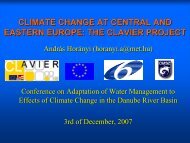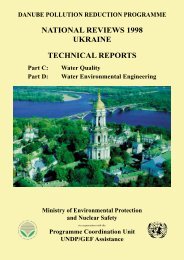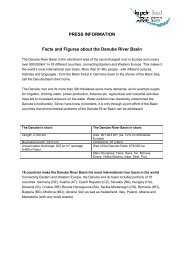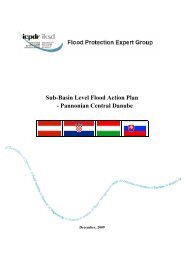1 Review of Agricultural Water Pollution Control Policy and ... - ICPDR
1 Review of Agricultural Water Pollution Control Policy and ... - ICPDR
1 Review of Agricultural Water Pollution Control Policy and ... - ICPDR
Create successful ePaper yourself
Turn your PDF publications into a flip-book with our unique Google optimized e-Paper software.
36<br />
How is information<br />
available to farmers?<br />
Are there any special<br />
projects or<br />
programmes for<br />
promoting GAP/BAP?<br />
UNDP/GEF Danube Regional Project<br />
respectively this document is rather worrying. The responsibility for its contents <strong>and</strong><br />
implementation is shared by several ministries (Health, Environment, Agriculture) <strong>and</strong> up<br />
to now it has not find its proper place in the agricultural practice.<br />
The first chapter "Principles <strong>of</strong> a good agricultural practice" deals with:<br />
Fertilization. This chapter refers to the "Guidelines for good agricultural practice in<br />
fertilization" (Official Journal <strong>of</strong> the Rep. Slovenia 34/00).<br />
Contents: to ensure a maximum uptake <strong>of</strong> nutrients by plants <strong>and</strong> minimum loss; to<br />
fertilize accordingly to the needs <strong>of</strong> individual crops; to respect water protection acts;<br />
different suggestions regarding the use, storage etc. <strong>of</strong> manure <strong>and</strong> slurry; a yearly<br />
fertilization plan according to the soil analysis (the later to be repeated every 5 years).<br />
Plant protection. This chapter refers to the Principles <strong>of</strong> good agricultural practice in plant<br />
protection (Ministry <strong>of</strong> Agriculture, Forestry <strong>and</strong> Food, 2000).<br />
Contents: optimisation <strong>of</strong> cultivation (time, hygiene, fertilisation, other technology etc); use <strong>of</strong><br />
resistant varieties; priority to non-chemical pest treatment; use <strong>of</strong> appropriate <strong>and</strong> registered<br />
pesticide; consider previous experiences <strong>and</strong> forecasts <strong>of</strong> the plant protection services;<br />
different measures to prevent occurrence <strong>of</strong> resistance in pests <strong>and</strong> to reduce the quantities<br />
<strong>of</strong> pesticides used; need for training on the use <strong>of</strong> pesticides; use <strong>of</strong> faultless <strong>and</strong> regularly<br />
checked spraying devices. The users must keep records on the use <strong>of</strong> pesticides.<br />
The second chapter is titled "Principles <strong>of</strong> a good farmer": This chapter refers to the Law<br />
on <strong>Agricultural</strong> L<strong>and</strong> (OJ RS 59/96) that requires from the owner, tenant or any other user<br />
<strong>of</strong> agricultural l<strong>and</strong> to farm the l<strong>and</strong> as a good farmer, adjusting agricultural production to<br />
the environmental <strong>and</strong> soil conditions <strong>and</strong> preventing erosion, pollution <strong>and</strong> ensuring a<br />
durable fertility <strong>of</strong> the soil. The criteria for a good farmer are set in the Guidelines for<br />
judging the appropriateness <strong>of</strong> the farmer's practice (OJ RS 29/86) that are the reference<br />
for the contents <strong>of</strong> the principles<br />
A small booklet on good agricultural practice has been published by the Ministry <strong>of</strong><br />
Environment <strong>and</strong> Spatial Planning. The booklet is not available anymore.<br />
No<br />
<strong>Policy</strong> Mix<br />
* Where 1 – highly successful (high potential to reduce water pollution plus high compliance/uptake by farmers); 2<br />
= moderately successful (moderate potential to reduce water pollution plus moderate compliance/uptake by<br />
farmers); 3 = unsuccessful (low potential to reduce water pollution plus <strong>and</strong>/or compliance/uptake by farmers)<br />
Practical<br />
<strong>Pollution</strong> <strong>Policy</strong> Instruments Potential to Effectiveness in<br />
On-farm Measures<br />
Issue<br />
Used Reduce Reducing <strong>Pollution</strong><br />
Reg Econ Adv Proj <strong>Pollution</strong> (average score)*<br />
CZECH REPUBLIC<br />
• nutrient <strong>and</strong> IPM<br />
• manure storage<br />
• organic farming<br />
• cleaning <strong>of</strong> pesticides dump<br />
Manure/fertilizers storage <strong>and</strong><br />
application, arable to grassl<strong>and</strong><br />
permits, permits for waste water<br />
discharge,<br />
Nutrients,<br />
farm waste<br />
erosion<br />
√ √ √ High 2<br />
Pesticides storage <strong>and</strong> use Pesticides √ √ High 2<br />
Waste management plans Waste √ High 1<br />
Action plan for NVZs Nutrients,<br />
waste<br />
Pesticides, fertilisers limits in Pesticide<br />
water/nature protected areas nutrients<br />
Organic farming Pesticides<br />
erosion,<br />
√ √ High 3 (will be<br />
implemented)<br />
√ High 1<br />
√ √ High 1



